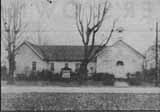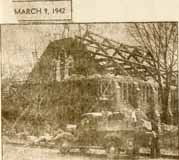‘Churches’ Category
Friday, September 26th, 2008

In my book I mentioned that the women of Clintonville were instrumental in building the community of Clintonville. According to North Broadway Methodist Church records, in 1906, the Ladies Aid Society was organized at Como Methodist Church. They pledged to earn $3000 a year for 5 years. They held bake sales and dinners, quilting parties and luncheons, and they met their goal. Their efforts were indispensable to construction of the Como Avenue Church Building and the Broadway Church. (Photo courtesy of North Broadway Methodist Church)
Posted in 1900-1940, Churches, People | No Comments »
Friday, September 26th, 2008
 The North Broadway Methodist Church (built 1924) was designed by architect James Boyd Martin, who also designed his own house at 190 East North Broadway. His home is complete with an architecturally-consistent play house to the rear. Martin’s house was made of Indiana Limestone with green roofing tiles. (The original plans for the church called for limestone as well, but changed to brick for budget reasons.) Martin also built the house at 155 North Broadway as a wedding gift for his daughter. His son, Boyd Gibson Martin, eventually joined the architectural firm (Martin, Orr & Martin) and designed his own house at 256 East North Broadway as well as the Worthington Presbyterian Church (in 1927) and the Worthington and Westerville Libraries. Sadly, the Great Depression put the architectural firm out of business. (Photo courtesy of Lynn McNish)
The North Broadway Methodist Church (built 1924) was designed by architect James Boyd Martin, who also designed his own house at 190 East North Broadway. His home is complete with an architecturally-consistent play house to the rear. Martin’s house was made of Indiana Limestone with green roofing tiles. (The original plans for the church called for limestone as well, but changed to brick for budget reasons.) Martin also built the house at 155 North Broadway as a wedding gift for his daughter. His son, Boyd Gibson Martin, eventually joined the architectural firm (Martin, Orr & Martin) and designed his own house at 256 East North Broadway as well as the Worthington Presbyterian Church (in 1927) and the Worthington and Westerville Libraries. Sadly, the Great Depression put the architectural firm out of business. (Photo courtesy of Lynn McNish)
Tags: N. Broadway
Posted in 1900-1940, Churches, Houses | No Comments »
Friday, September 26th, 2008


In 1925, members of Maple Grove Church presented a play at the church. The play was Friendly Helpers Class. It was a success and was taken on the road to the Linworth and King Avenue Methodist Churches. The left photo shows cast members Katherine Cooke (Barbee) and Lulu Browne (Ohsner), Dorothy Cooke (Hambleton) and a neighbor playacting for the camera in 1925. The photo on the right is the program for the June production. (Photo courtesy of the Ron Ohsner Family)
Tags: Cooke family, Henderson, Maple Grove Area, Maple Grove Church
Posted in 1800s, 1900-1940, Churches, Parks & Recreation, People, Schools | 1 Comment »
Friday, September 26th, 2008

Crestview and Overbrook Presbyterian Churches were organized by the Reverends Walter Houston and Harry Barr, and both claim this “tin church” as their first home. In 1915 the Crestview congregation purchased five lots at Tulane and Esmond. They met in the tin church until 1918, when a more permanent structure was erected. In 1922 a larger church was built; the first brick structure was converted to a manse. (Photo courtesy of Overbrook Presbyterian Church)
Tags: Crestview Presbyterian Church, Overbrook Presbyterian Church
Posted in 1900-1940, Churches | No Comments »
Friday, September 26th, 2008
 This is the newer Crestview Presbyterian Church, built in 1922 at Tulane and Esmond. (Photo courtesy of the Clintonville Historical Society)
This is the newer Crestview Presbyterian Church, built in 1922 at Tulane and Esmond. (Photo courtesy of the Clintonville Historical Society)
Tags: Clintonville Historical Society collection, Crestview Presbyterian Church
Posted in 1900-1940, Churches | No Comments »
Friday, September 26th, 2008
One of the oldest churches associated with Clintonville is surely the First Free Methodist Church, named so because they did not believe in charging members for pews. The church is over 100 years old (started 1906) and in the 1920s was located at 57 Weber Road. In recent times the church changed its name to Church of Living Hope and is presently located at 4147 Westerville Road.
Posted in 1900-1940, Churches | No Comments »
Friday, September 26th, 2008
Tags: Immaculate Conception
Posted in 1900-1940, Churches | No Comments »
Friday, September 26th, 2008
 Maple Grove Church in 1939. Originally owned by John Buck, by 1842 the property on the southwest corner of today’s Henderson Road and North High Street was owned by Chauncey Cooke. Chauncey leased the lot to the directors of Clinton Township School District No 1, and the lease contained the clause “to have and to hold said demised premises as long as they shall be used for school purposes.” A clause was also added “that the lot and building to be erected thereon shall be used for Public Worship by any Christian denomination for the accommodation of the neighborhood.” Lore has it that the lease was not recorded but was held by the Clinton township clerk for a number of years, and the late Mr. L. L. Pegg found it in the corn crib of the township clerk in the year 1919.
Maple Grove Church in 1939. Originally owned by John Buck, by 1842 the property on the southwest corner of today’s Henderson Road and North High Street was owned by Chauncey Cooke. Chauncey leased the lot to the directors of Clinton Township School District No 1, and the lease contained the clause “to have and to hold said demised premises as long as they shall be used for school purposes.” A clause was also added “that the lot and building to be erected thereon shall be used for Public Worship by any Christian denomination for the accommodation of the neighborhood.” Lore has it that the lease was not recorded but was held by the Clinton township clerk for a number of years, and the late Mr. L. L. Pegg found it in the corn crib of the township clerk in the year 1919.
Tags: Henderson, Maple Grove Area, Maple Grove Church
Posted in 1800s, 1900-1940, Churches | No Comments »
Friday, September 26th, 2008

I don’t know who these Immaculate Conception people are (email me if you recognize anyone here). But it is a wonderful and classic picture of kitchen workers of some function held by the church, don’t you agree? (Photo courtesy of Immaculate Conception)
 An IC fashion show. (Photograph courtesy of Immaculate Conception)
An IC fashion show. (Photograph courtesy of Immaculate Conception)
Tags: Immaculate Conception
Posted in 1900-1940, Churches | No Comments »
Friday, September 19th, 2008
 The old brick school house which became the foundational building of Maple Grove Church was originally built in 1878. The church was organized around 1919, and began meeting in the abandoned school around 1920. In 1923 a frame addition was dedicated and this served as their parish hall for many years. In 1929 the lot was further expanded, and a campaign for new construction began shortly thereafter. (Photo courtesy of the Maple Grove Methodist Church)
The old brick school house which became the foundational building of Maple Grove Church was originally built in 1878. The church was organized around 1919, and began meeting in the abandoned school around 1920. In 1923 a frame addition was dedicated and this served as their parish hall for many years. In 1929 the lot was further expanded, and a campaign for new construction began shortly thereafter. (Photo courtesy of the Maple Grove Methodist Church)
 The cornerstone was laid on Pearl Harbor Day in 1941. A stop light was installed at the corner of Henderson and High in 1940—a real sign of growth and “progress.”
The cornerstone was laid on Pearl Harbor Day in 1941. A stop light was installed at the corner of Henderson and High in 1940—a real sign of growth and “progress.”
(Photo courtesy of the Maple Grove Methodist Church)
Tags: Henderson, Maple Grove Area, Maple Grove Church
Posted in 1900-1940, 1940-present, Churches | 1 Comment »

 The North Broadway Methodist Church (built 1924) was designed by architect James Boyd Martin, who also designed his own house at 190 East North Broadway. His home is complete with an architecturally-consistent play house to the rear. Martin’s house was made of Indiana Limestone with green roofing tiles. (The original plans for the church called for limestone as well, but changed to brick for budget reasons.) Martin also built the house at 155 North Broadway as a wedding gift for his daughter. His son, Boyd Gibson Martin, eventually joined the architectural firm (Martin, Orr & Martin) and designed his own house at 256 East North Broadway as well as the Worthington Presbyterian Church (in 1927) and the Worthington and Westerville Libraries. Sadly, the Great Depression put the architectural firm out of business. (Photo courtesy of Lynn McNish)
The North Broadway Methodist Church (built 1924) was designed by architect James Boyd Martin, who also designed his own house at 190 East North Broadway. His home is complete with an architecturally-consistent play house to the rear. Martin’s house was made of Indiana Limestone with green roofing tiles. (The original plans for the church called for limestone as well, but changed to brick for budget reasons.) Martin also built the house at 155 North Broadway as a wedding gift for his daughter. His son, Boyd Gibson Martin, eventually joined the architectural firm (Martin, Orr & Martin) and designed his own house at 256 East North Broadway as well as the Worthington Presbyterian Church (in 1927) and the Worthington and Westerville Libraries. Sadly, the Great Depression put the architectural firm out of business. (Photo courtesy of Lynn McNish)


 This is the newer Crestview Presbyterian Church, built in 1922 at Tulane and Esmond. (Photo courtesy of the Clintonville Historical Society)
This is the newer Crestview Presbyterian Church, built in 1922 at Tulane and Esmond. (Photo courtesy of the Clintonville Historical Society)





 The old brick school house which became the foundational building of Maple Grove Church was originally built in 1878. The church was organized around 1919, and began meeting in the abandoned school around 1920. In 1923 a frame addition was dedicated and this served as their parish hall for many years. In 1929 the lot was further expanded, and a campaign for new construction began shortly thereafter. (Photo courtesy of the Maple Grove Methodist Church)
The old brick school house which became the foundational building of Maple Grove Church was originally built in 1878. The church was organized around 1919, and began meeting in the abandoned school around 1920. In 1923 a frame addition was dedicated and this served as their parish hall for many years. In 1929 the lot was further expanded, and a campaign for new construction began shortly thereafter. (Photo courtesy of the Maple Grove Methodist Church) The cornerstone was laid on Pearl Harbor Day in 1941. A stop light was installed at the corner of Henderson and High in 1940—a real sign of growth and “progress.”
The cornerstone was laid on Pearl Harbor Day in 1941. A stop light was installed at the corner of Henderson and High in 1940—a real sign of growth and “progress.”